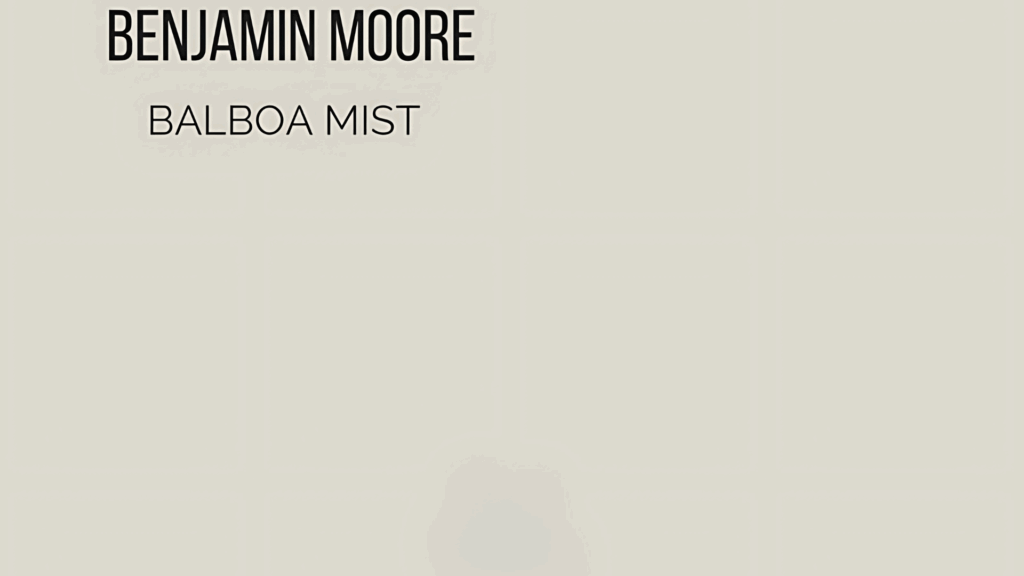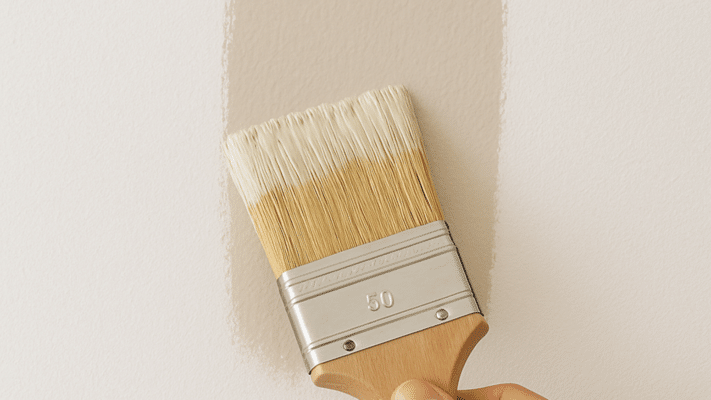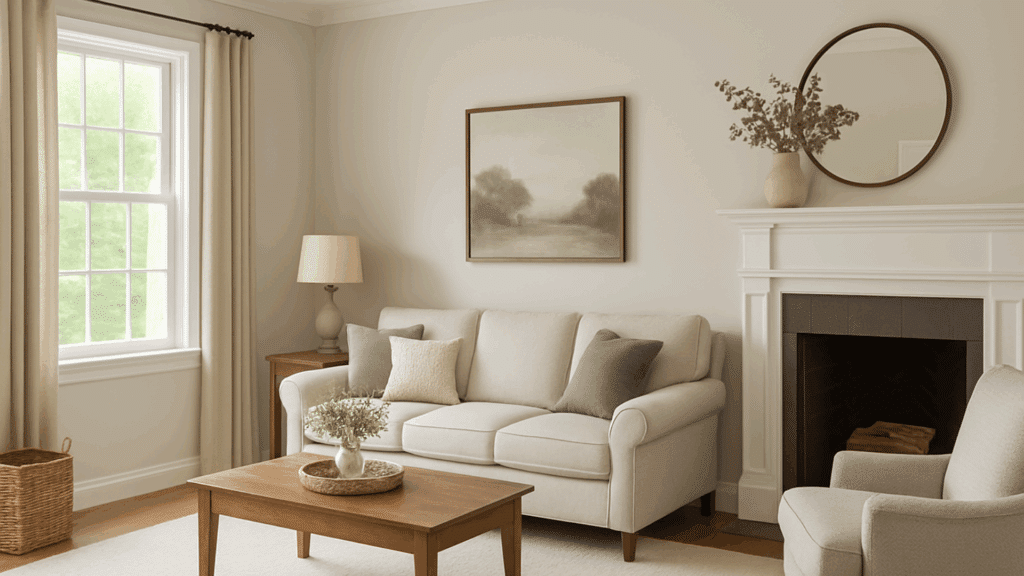When I first came across Balboa Mist by Benjamin Moore, I didn’t think much of it.
At first glance, it looked like just another gray. But after trying it in my own space, I realized why so many people recommend it.
This shade has a balance that makes it stand out. It feels warm without turning beige and soft without looking too light.
That balance is why it works in so many homes.
In this guide, I’ll share the official details of BM Balboa Mist, including its color code, light reflectance value, undertones, and finish options.
I’ll also go over how it reacts to different lighting, what trims and accents pair with it, and how it compares to other similar shades.
What Is Balboa Mist by Benjamin Moore?

Benjamin Moore lists Balboa Mist as OC-27, though you may also see it under 1549. Both codes refer to the same color.
It’s part of the Off White Collection, which is made up of light neutrals that serve as soft backdrops. While the collection suggests “off white,” Balboa Mist reads more like a pale gray with a warm edge.
These are the key properties of Balboa Mist:
- Color Name and Code: Balboa Mist OC-27 (also 1549)
- Collection: Off White Collection
- LRV (Light Reflectance Value): 65.53
- Color Family: Gray / Greige
- Undertones: Soft violet-taupe that can shift slightly pink in some light
- Finish Availability: Available in all standard Benjamin Moore finishes
With a mid-range LRV, Balboa Mist reflects enough light to keep rooms bright but has enough depth to avoid looking washed out.
Understanding Balboa Mist Undertones

Balboa Mist sits in the gray family, but it’s not a plain gray. It leans into greige, which means a gray with beige mixed in. That touch of warmth makes it feel welcoming instead of stark.
The undertones are where it gets interesting. Most people describe it as having a soft taupe cast with subtle violet undertones.
Depending on the light, you might even see a hint of pink. This doesn’t mean it looks purple, as it’s more of a whisper that comes through in certain lighting conditions.
This is one reason some folks love it and others get caught off guard.
If your room gets a lot of natural light bouncing off green trees or red brick, you may notice the undertones shifting slightly.
Pros and Cons of BM Balboa Mist

Like any paint color, Balboa Mist has its strengths and limitations. Knowing both will help you decide if it’s the right fit for your home.
| Pros | Cons |
|---|---|
|
Balanced LRV (65) keeps rooms bright but grounded Undertones add warmth without feeling cold Fits many styles: modern, farmhouse, coastal Works on walls, cabinets, and trim |
It can look washed out on large exteriors Undertones may shift in certain lighting Not a bold or dramatic color May show hints of green or pink in some spaces |
Overall, Balboa Mist is a versatile color that adapts well, but it’s best for those looking for a subtle, balanced neutral rather than a high-impact choice.
Applications and Best Uses of BM Balboa Mist Color

Balboa Mist is one of those shades that works almost anywhere, but there are a few spots where it really shines. Its balance between warm and cool makes it versatile for different styles and spaces.
- Living rooms: Creates a neutral base that pairs easily with light or dark furniture.
- Bedrooms: Soft and calming, especially when styled with white bedding or light wood accents.
- Kitchens: Works well on walls with white cabinets or even as a cabinet color itself.
- Open concept areas: Flows seamlessly between connected rooms, keeping a consistent look.
- Dining rooms: Adds a touch of warmth without competing with decor or lighting fixtures.
- Hallways: Brightens narrow spaces while keeping them grounded.
What I enjoy most is how well Balboa Mist complements different finishes. No matter if it’s warm wood floors, crisp white trim, or even stone fireplaces, it blends in naturally without feeling flat.
Comparisons with Similar Colors of BM Balboa Mist

Balboa Mist often gets compared to other popular neutrals in the Benjamin Moore and Sherwin-Williams lineups.
The differences may seem small on paper, but undertones and reflectiveness can really change how these colors look in a space.
| Paint Color | LRV | Undertone | How It Compares |
|---|---|---|---|
| Balboa Mist (BM OC-27 / 1549) | 65.53 | Warm gray with violet-taupe | Balanced and versatile, it shows subtle warmth |
| Classic Gray (BM 1548) | 74 | Warm gray | Lighter and brighter, less contrast with white trim |
| Egret White (SW 7570) | ~70 | Warm gray-beige | About 25% lighter, softer, and more muted than Balboa Mist |
| Collingwood (BM OC-28) | 62 | Muted violet-gray | Slightly darker, flatter; Balboa Mist feels warmer |
Seeing these shades side by side can help you decide which one fits your space best. Even small differences in undertones can affect how a room feels once the paint is on the wall.
Choosing the Right Finish for Balboa Mist

Balboa Mist is available in all standard Benjamin Moore finishes, which makes it easy to use across different surfaces in your home. The finish you choose depends on the look and durability you need.
- Walls: Matte or eggshell finishes are most common. These give a smooth, soft look and work well in living rooms, bedrooms, and hallways.
- Trim and Cabinets: Satin or semi-gloss finishes are recommended. They add a subtle sheen, highlight architectural details, and are easier to clean.
- Ceilings: Flat finishes work best here since they reduce glare.
As for coverage, a gallon of Benjamin Moore paint typically covers 350 to 400 square feet per coat, depending on the surface and application. Two coats are usually recommended for the best depth and finish.
How Lighting Affects Balboa Mist
Balboa Mist is one of those colors that doesn’t stay exactly the same throughout the day. Its undertones and warmth shift depending on the type of light in the room.
In south- or west-facing rooms, the color tends to look warmer and shows off more of its soft gray side. It feels cozy, calm, and inviting, especially during the afternoon when the sun is stronger.
In north-facing rooms, where light is cooler, Balboa Mist leans more into greige. Here, it can look slightly muted, sometimes even a touch shadowed, compared to brighter rooms.
With artificial lighting, the effect depends on your bulbs. Warm bulbs pull out its beige side, while cooler bulbs make it read more like a simple, clean gray.
Tips for Using Benjamin Moore Balboa Mist
Balboa Mist is versatile, but like any paint color, how you use it makes all the difference. A few simple steps can help you get the best results in your space.
- Test before committing: Paint large samples on different walls and view them at different times of day.
- Pair with the right trim: Crisp whites like Chantilly Lace add contrast, while White Dove keeps it soft.
- Check your lighting: Warm bulbs will bring out beige tones, while cooler bulbs highlight the gray side.
- Match with materials: Works best with natural wood, stone, or warm flooring.
- Use in open spaces: Its balance helps it flow smoothly across connected rooms.
- Balance undertones: Add navy or green accents if the violet undertones feel too strong.
With a little planning, Balboa Mist can adapt beautifully to almost any style. Paying attention to trim, lighting, and accents will make the color feel intentional rather than accidental.
Conclusion
If you came here searching for Balboa Mist Benjamin Moore, you now have the essentials. You know its color codes, collection, and LRV, along with how its undertones shift in different lighting.
I’ve shared where it works best, the trims and accents that complement it, and the finishes that make the most sense for walls, ceilings, and cabinets.
You’ve also seen how it stacks up against close shades like Classic Gray and Collingwood.
With this information, you can decide if BM Balboa Mist is the right fit for your space. It’s not just a number on a chart, as it’s a flexible, balanced neutral that adapts to its surroundings.
Now you have what you need to choose with confidence!

